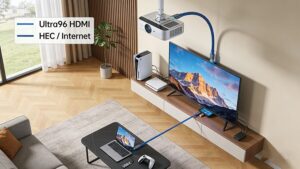In the ever-evolving world of technology, HDMI cables remain a linchpin for seamless audio – visual connectivity. As we dive into 2025, several exciting trends are shaping the HDMI cable landscape, making it an opportune time to take a closer look at what’s new, how it impacts your setup, and what to consider when choosing the right cable for your needs.
The Arrival of HDMI 2.2
In June 2025, the HDMI Forum officially unveiled the final specifications of HDMI 2.2, bringing some significant upgrades to the table. One of the most talked – about enhancements is the dramatic increase in bandwidth. HDMI 2.2 boasts a staggering 96 Gbps of bandwidth, doubling that of its predecessor, HDMI 2.1, which had a maximum of 48 Gbps. This leap in bandwidth enables the support of some truly mind – boggling resolution and refresh rate combinations. For instance, it can handle up to 240Hz at 4K resolution and 60Hz at 8K resolution in the 4:4:4 format with a color depth of up to 12 bits. Additionally, it supports 12K@120Hz and 16K@60Hz resolutions when using DSC (Display Stream Compression) technology.
How Does HDMI 2.2 Compare to Previous Versions?
Let’s take a moment to compare HDMI 2.2 with its predecessors, HDMI 2.1 and HDMI 2.0, in terms of key features:
|
Feature
|
HDMI 2.0
|
HDMI 2.1
|
HDMI 2.2
|
|
Bandwidth
|
18 Gbps
|
48 Gbps
|
96 Gbps
|
|
Max Resolution (without DSC)
|
4K@60Hz
|
8K@60Hz, 4K@120Hz
|
8K@240Hz, 12K@120Hz, 16K@60Hz
|
|
Audio Return Channel (ARC)
|
Standard ARC
|
eARC (Enhanced ARC)
|
eARC
|
|
Variable Refresh Rate (VRR)
|
No
|
Yes
|
Yes
|
|
Delay Indication Protocol (LIP)
|
No
|
No
|
Yes
|
As you can see from the table, HDMI 2.2 represents a substantial upgrade over previous versions, especially in terms of bandwidth and support for higher resolutions and refresh rates.
Do You Need to Upgrade Your HDMI Cables?
While HDMI 2.2 offers some impressive features, the question on many consumers’ minds is whether they need to rush out and upgrade their existing HDMI cables. The answer, for most, is likely no – at least not yet.
Currently, the majority of consumer – grade display devices, such as TVs and monitors, are still based on 4K or 8K technology. HDMI 2.1, with its 48 Gbps bandwidth, is more than sufficient to handle 8K@60Hz and 4K@120Hz content, which are the current standards for high – end displays. Gaming consoles like the PlayStation 5 and Xbox Series X also operate within the capabilities of HDMI 2.1.
Moreover, the content ecosystem for 12K and 16K resolutions is virtually non – existent at present. Streaming services and game developers are still primarily focused on delivering high – quality 4K@60Hz content. Additionally, the cost of Ultra96 – certified HDMI 2.2 cables is expected to be higher due to their more complex manufacturing process, and devices that fully support HDMI 2.2 are not expected to be widely available until late 2025 or even 2026.
However, if you are an early adopter, a professional in a field that requires the highest – resolution displays (such as medical imaging or high – end video production), or if you simply want to future – proof your setup, then investing in HDMI 2.2 – compatible cables and devices might be worth considering.
Choosing the Right HDMI Cable for Your Needs
Whether you’re sticking with HDMI 2.1 or considering an upgrade to HDMI 2.2 in the future, choosing the right HDMI cable is crucial for optimal performance. Here are some factors to keep in mind:
1. Version Compatibility
First and foremost, ensure that the cable is compatible with the HDMI version of your devices. If you have an older TV or monitor that only supports HDMI 2.0, there’s no point in buying a high – end HDMI 2.2 cable as it won’t be able to take full advantage of the cable’s capabilities. Similarly, if you plan to use a device that supports HDMI 2.2 in the future, make sure the cable you buy is HDMI 2.2 – compliant.
2. Bandwidth Requirements
Match the bandwidth of the cable to the resolution and refresh rate you want to achieve. For example, if you have a 4K@120Hz monitor, you’ll need a cable with at least 48 Gbps of bandwidth, such as an HDMI 2.1 cable. If you’re aiming for 8K@60Hz or higher resolutions, an HDMI 2.2 cable with 96 Gbps bandwidth would be necessary.
3. Build Quality
Look for cables with a sturdy build. The cable should have a thick outer jacket to protect against wear and tear, and the connectors should be made of high – quality materials, such as gold – plated connectors. Gold – plating helps to improve conductivity and resist corrosion, ensuring a reliable connection over time.
4. Certification
Conclusion
HDMI cables evolve constantly, with HDMI 2.2 a big leap in AV tech. While it offers exciting new features like higher bandwidth and improved audio – video synchronization, most consumers can comfortably stick with HDMI 2.1 for the time being. However, as technology continues to advance and 12K and 16K content becomes more prevalent, HDMI 2.2 will likely become the standard. By understanding the latest trends and considering your specific needs, you can make an informed decision when it comes to choosing the right HDMI cable for your home entertainment or professional setup.
Remember, at Foyun, we are committed to providing high – quality HDMI cables that meet the latest industry standards. Whether you’re looking for a reliable HDMI 2.1 cable or want to be among the first to experience the benefits of HDMI 2.2, we’ve got you covered. Browse our range of HDMI cables on our independent website today and take your audio – visual experience to the next level.







